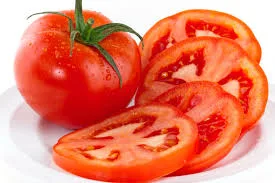Whether you refer to tomato as a fruit or a vegetable, there is no doubt that a tomato is a nutrient-dense, super-food that most people should be eating more of. The tomato has been referred to as a "functional food," a food that goes beyond providing just basic nutrition, additionally preventing chronic diseases and delivering other health benefits, due to beneficial phytochemicals such as lycopene. Despite the popularity of the tomato, only 200 years ago it was thought to be poisonous in the U.S., likely because the plant belongs to the nightshade family, of which some species are truly poisonous.
The benefits of consuming fruits and vegetables of all kinds, including tomatoes, are infinite. As plant food consumption goes up, the risk of heart disease, diabetes, and cancer goes down. High fruit and vegetable intake is also associated with healthy skin and hair, increased energy and lower weight. Increasing consumption of fruits and vegetables significantly decreases the risk of obesity and overall mortality.
As an excellent source of the strong antioxidant vitamin C and other antioxidants, tomatoes can help combat the formation of free radicals known to cause cancer. Lycopene has been linked with prostate cancer prevention in several studies. According to John Erdman, Ph.D., Professor Emeritus of the department of food science and human nutrition at the University of Illinois, "There's very good, strong, epidemiological support for increased consumption of tomato products and lower incidence of prostate cancer.
Among younger men, diets rich in beta-carotene may play a protective role against prostate cancer, according to a study conducted by the Harvard School of Public Health's Department of Nutrition. Beta-carotene consumption has been shown to have an inverse association with the development of colon cancer in the Japanese population. High fiber intakes from tomatoes are associated with a lowered risk of colorectal cancer.
The fiber, potassium, vitamin C and chlorine content in tomatoes all support heart health. An increase in potassium intake along with a decrease in sodium intake is the most important dietary change that a person can make to reduce their risk of cardiovascular disease, according to Mark Houston, M.D., M.S., an associate clinical professor of medicine at Vanderbilt Medical School and director of the Hypertension Institute at St. Thomas Hospital in Tennessee. In one study, those who consumed 4069 mg of potassium per day had a 49 percent lower risk of death from ischemic heart disease compared with those who consumed less potassium (about 1000 mg per day). High potassium intakes are also associated with a reduced risk of stroke, protection against loss of muscle mass, preservation of bone mineral density and reduction in the formation of kidney stones. Studies have shown that type 1 diabetics who consume high-fiber diets have lower blood glucose levels and type 2 diabetics may have improved blood sugar, lipids and insulin levels. One cup of cherry tomatoes provides about 2 grams of fiber and potassium.
Collagen, the skins support system, is reliant on vitamin C as an essential nutrient that works in our body as an antioxidant to help prevent damage caused by the sun, pollution and smoke, smooth wrinkles and improve overall skin texture. Eating foods that are high in water content and fiber like tomatoes can help to keep you hydrated and your bowel movements regular. Fiber is essential for minimizing constipation and adding bulk to the stool.
Adequate folic acid intake is essential for pregnant women to protect against neural tube defects in infants. The folic acid in tomatoes may also help with depression by preventing an excess of homocysteine from forming in the body, which can prevent blood and other nutrients from reaching the brain. Excess homocysteine interferes with the production of the feel-good hormones serotonin, dopamine, and norepinephrine, which regulate not only mood, but sleep and appetite as well. One medium tomato (approximately 123 grams) provides 22 calories, 0 grams of fat, 5 grams of carbohydrate (including 1 gram of fiber and 3 grams of sugar) and 1 gram of protein. Alpha-lipoic acid helps the body to convert glucose into energy. Some evidence suggests that alpha-lipoic acid can aid in blood glucose control, improve vasodilation and protect against retinopathy in diabetic patients and may even help preserve brain and nerve tissue.
Lycopene is the antioxidant that gives tomatoes their rich red color. Tomatoes account for 80 percent of lycopene consumption. Choline is an important nutrient found in tomatoes that helps with sleep, muscle movement, learning and memory. Choline also helps to maintain the structure of cellular membranes, aids in the transmission of nerve impulses, assists in the absorption of fat and reduces chronic inflammation.



























